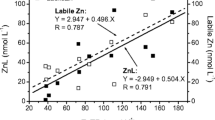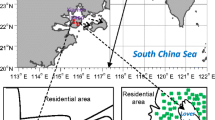Abstract
Cobalt distribution and speciation were quantified in space and time in the water column of a small, stratified, eutrophic lake, Linsley Pond, North Branford, CT. While scrupulously employing clean techniques, we used ligand exchange with dimethylglyoxime and cathodic stripping voltammetry to evaluate free and complexed forms of Co. Free aquo Co ion concentrations [Co2+] were found in the range from 0.014 to 0.28 nM from June to October 2018. Despite the orthograde distribution for total dissolved Co (0.42–3.34 nM), free Co2+ was higher in the epilimnion, decreasing with depth. Natural organic ligand concentrations [L] were in the span from 0.7 to 8.1 nM, with conditional stability constants (as logK) in the range from 9.43 to 11.13. Nearly all of the Co was complexed with highly selective ligands, and patterns suggest three controlling processes: (1) Co release from dissolving Mn (and perhaps Fe) oxides, (2) possible limitation by solubility of CoS(s), and (3) stabilization in solution via complexation by strong ligands. No correlation was observed between dissolved organic carbon and [L] in this study, suggesting that the ligands are not a simple subset of total dissolved organic matter, but may be specific compounds, perhaps S based. The hypothesis that the biological activity of plankton in Linsley Pond might be limited by micronutrient Co is only weakly supported. Cobalamin (VB12) measured via enzyme-linked immunosorbent assays ranged from 0.033 to 0.048 nM in this lake and does not follow a simple pattern with either total dissolved Co or Co2+, or with biological activity as indicated by chlorophyll levels.














Similar content being viewed by others
Data availability
The datasets generated during and/or analyzed during the current study are available from the corresponding author on reasonable request.
References
Al-Farawati R, El Sayed MA, Shaban YA, Turki AJ (2016) Occurrence of copper-complexing ligands in the coastal sediments of eastern Red Sea. Arab J Geosci 9:1–9
Allen HE, Hansen DJ (1996) The importance of trace metal speciation to water quality criteria. Water Environ Res 68:42–54
Allison AC, Arnstein HR (1961) Effect of vitamin B12 and 2 vitamin B12 antagonists on growth of HeLa cells in tissue culture and of Ochromonas malhamensis. Biochem Biophys Acta 49:566–570
Aviva Systems Biology (2020) Vitamin B12 ELISA kit (OKEH02574) product manual
Balistrieri LS, Murray JW, Paul B (1994) The geochemical cycling of trace-elements in a biogenic meromictic lake. Geochim Cosmochim Acta 58:3993–4008
Batley GE (1986) Interferences in the determination of copper in natural waters by anodic stripping voltammetry. Anal Chim Acta 189:371–377
Batley GE, Florence TM (1975) Determination of thallium in natural waters by anodic stripping voltammetry. J Electroanal Chem 61:205–211
Benoit RJ (1957) Preliminary observations on cobalt and vitamin-B12 in fresh water. Limnol Oceanogr 2:233–240
Benoit G, Hunter KS, Rozan TF (1997) Sources of trace metal contamination artifacts during collection, handling, and analysis of freshwaters. Anal Chem 69:1006–1011
Bratina BJ, Stevenson BS, Green WJ, Schmidt TM (1998) Manganese reduction by microbes from oxic regions of the Lake Vanda (Antarctica) water column. Appl Environ Microbiol 64:3791–3797
Brugam RB (1975) The human disturbance history of Linsley Pond, North Branford, CT. Ph.D. thesis. Yale University.
Buck KN, Moffett J, Barbeau KA, Bundy RM, Kondo Y, Wu J (2012) The organic complexation of iron and copper: An intercomparison of competitive ligand exchange-adsorptive cathodic stripping voltammetry (CLE-ACSV) techniques. Limnol Oceanogr Methods 10:496–515
Buffle J, Tercier-Waeber ML (2005) Voltammetric environmental trace-metal analysis and speciation: from laboratory to in situ measurements. Trac-Trend Anal Chem 24:172–191
Chakraborty P, Chakrabarti CL (2006) Chemical speciation of Co, Ni, Cu, and Zn in mine effluents and effects of dilution of the effluent on release of the above metals from their metal-dissolved organic carbon (DOC) complexes. Anal Chim Acta 571:260–269
Collins RN, Kinsela AS (2010) The aqueous phase speciation and chemistry of cobalt in terrestrial environments. Chemosphere 79:763–771
Daisley KW (1969) Monthly survey of vitamin B12 concentrations in some waters of English lake district. Limnol Oceanogr 14:224–230
Di Toro DM, Allen HE, Bergman HL, Meyer JS, Paquin PR, Santore RC (2001) Biotic ligand model of the acute toxicity of metals. 1 Technical basis. Environ Toxicol Chem 20:2383–2396
Downs T, Schallenberg M, Burns C (2008) Responses of lake phytoplankton to micronutrient enrichment: a study in two New Zealand lakes and an analysis of published data. Aquat Sci 70:347–360
Facey JA, King JJ, Apte SC, Mitrovic SM (2022a) Assessing the importance of cobalt as a micronutrient for freshwater cyanobacteria. J Phycol 58:71–79
Facey JA, Michie LE, King JJ, Hitchcock JN, Apte SC, Mitrovic SM (2022b) Severe cyanobacterial blooms in an Australian lake; causes and factors controlling succession patterns. Harmful Algae 117:102284
Fan XF et al (2021) A holistic understanding of cobalt cycling and limiting roles in the eutrophic Lake Taihu. Chemosphere 277:1430234
Fasfous II et al (2004) Kinetics of trace metal competition in the freshwater environment: some fundamental characteristics. Environ Sci Technol 38:4979–4986
Frigaard NU, Dahl C (2008) Sulfur Metabolism in phototrophic sulfur bacteria. In: Poole RK (ed) Advances in microbial physiology. Academic Press, New York, pp 103–200
Gillespie PA, Morita RY (1972) Vitamin-B12 production and depletion in a naturally occurring eutrophic lake. Appl Microbiol 23:341
Goldman CR (1964) Primary productivity and micronutrient limitation in some North American and New Zealand lakes. SIL Proc 15:365–374
Goldman CR (1972) The role of minor nutrients in limiting the productivity of aquatic ecosystems. In: Likens GE (ed) Proceedings of the symposium on nutrients and eutrophication: the limiting-nutrient controversy. American Society of Limnology and Oceanography, pp 21–23
Green WJ, Ferdelman TG, Canfield DE (1989) Metal dynamics in Lake Vanda (Wright Valley, Antarctica). Chem Geol 76:85–94
Hao Z, Vire JC, Patriarche GJ, Wollast R (1988) Determination of cobalt ions in natural-waters using differential pulse adsorptive stripping voltammetry. Anal Lett 21:1409–1424
Holmhansen O, Gerloff GC, Skoog F (1954) Cobalt as an essential element for blue-green algae. Physiol Plant 7:665–675
Hu H, Mylon SE, Benoit G (2006) Distribution of the thiols glutathione and 3-mercaptopropionic acid in Connecticut lakes. Limnol Oceanogr 51:2763–2774
Hutchinson GE (1957) A treatise on limnology. Wiley, Oxford
Jansen S, Steffen F, Threels WF, Van Leeuwen HP (2005) Speciation of Co(II) and Ni(II) in anaerobic bioreactors measured by competitive ligand exchange—adsorptive stripping voltammetry. Environ Sci Technol 39:9493–9499
Kim JH, Gibb HJ, Howe PD (2006) Cobalt and inorganic cobalt compounds. World Health Organization, pp 1–85
Laglera LM, Van Den Berg CMG (2003) Copper complexation by thiol compounds in estuarine waters. Mar Chem 82:71–89
Lam MT, Murimboh J, Hassan NM, Chakrabarti CL (1999) Competitive ligand exchange/adsorptive cathodic stripping voltammetry (CLE/AdCSV) for kinetic studies of nickel speciation in aqueous environmental samples containing heterogeneous, macromolecular, organic complexants. Anal Chim Acta 402:195–209
Lorenzo JI, Nieto O, Beiras R (2002) Effect of humic acids on speciation and toxicity of copper to Paracentrotus lividus larvae in seawater. Aquat Toxicol 58:27–41
Muyzer G, Stams AJM (2008) The ecology and biotechnology of sulphate-reducing bacteria. Nat Rev Microbiol 6:441–454
Nagpal NK (2004) Technical report—water quality guidelines for cobalt. Ministry of Water, Land and Air Protection, pp 1–59
Nason JA, Sprick MS, Bloomquist DJ (2012) Determination of copper speciation in highway stormwater runoff using competitive ligand exchange—adsorptive cathodic stripping voltammetry. Water Res 46:5788–5798
Neal C et al (1997) Trace element inter-relationships for the Humber rivers. Inferences for hydrological and chemical controls. Sci Total Environ 194:321–343
Nishijima T, Hata Y (1977) Distribution of thiamine, biotin, and vitamin-B12 in Lake Kojima. 1. Distribution in lake water. B Jpn Soc Sci Fish 43:1403–1410
Ohwada K, Taga N (1972) Vitamin-B12, thiamine, and biotin in Lake Sagami. Limnol Oceanogr 17:315–320
Ohwada K, Otsuhata M, Taga N (1972) Seasonal cycles of vitamin-B12, thiamine and biotin in surface water of Lake Tsukui. B Jpn Soc Sci Fish 38:817–820
Okbamichael M, Sanudo-Wilhelmy SA (2004) A new method for the determination of Vitamin B-12 in seawater. Anal Chim Acta 517:33–38
Paquin PR et al (2002) The biotic ligand model: a historical overview. Comp Biochem Physiol C Toxicol Pharmacol 133:3–35
Pesavento M, Alberti G, Biesuz R (2009) Analytical methods for determination of free metal ion concentration, labile species fraction and metal complexation capacity of environmental waters: a review. Anal Chim Acta 631:129–141
Qian J, Xue HB, Sigg L, Albrecht A (1998) Complexation of cobalt by natural ligands in freshwater. Environ Sci Technol 32:2043–2050
Robbins WJ, Hervey A, Stebbins ME (1950) Studies on Euglena and Vitamin-B12. Science 112:455–455
Saito MA, Moffett JW, Chisholm SW, Waterbury JB (2002) Cobalt limitation and uptake in Prochlorococcus. Limnol Oceanogr 47:1629–1636
Sauvage J et al (2021) Biodegradable, metal-chelating compounds as alternatives to EDTA for cultivation of marine microalgae. J Appl Phycol 33:3519–3537
Sekaly ALR et al (2003) Kinetic speciation of Co(II), Ni(II), Cu(II), and Zn(II) in model solutions and freshwaters: lability and the d electron configuration. Environ Sci Technol 37:68–74
Sigg L, Behra R (2005) Speciation and bioavailability of trace metals in freshwater environments. Met Ions Biol Syst 44:47–73
Sunda W, Guillard RRL (1976) Relationship between cupric ion activity and toxicity of copper to phytoplankton. J Mar Res 34:511–529
Taillefert M, Macgregor BJ, Gaillard JF, Lienemann CP, Perret D, Stahl DA (2002) Evidence for a dynamic cycle between Mn and Co in the water column of a stratified lake. Environ Sci Technol 36:468–476
Twining BS, Mylon SE, Benoit G (2007) Potential role of copper availability in nitrous oxide accumulation in a temperate lake. Limnol Oceanogr 52:1354–1366
Van Leeuwen HP, Jansen S (2005) Dynamic aspects of metal speciation by competitive ligand exchange-adsorptive stripping voltammetry (CLE-AdSV). J Electroanal Chem 579:337–342
Van Leeuwen HP, Town RM (2005) Kinetic limitations in measuring stabilities of metal complexes by competitive ligand exchange-adsorptive stripping voltammetry (CLE-AdSV). Environ Sci Technol 39:7217–7225
Warnken KW, Davison W, Zhang H, Galceran J, Puy J (2007) In situ measurements of metal complex exchange kinetics in freshwater. Environ Sci Technol 41:3179–3185
Xue H, Sunda WG (1997) Comparison of [Cu2+] measurements in lake water determined by ligand exchange and cathodic stripping voltammetry and by ion-selective electrode. Environ Sci Technol 31:1902–1909
Xue H, Sigg L (2002) A review of competitive ligand-exchange-voltammetric methods for speciation of trace metals in freshwater. ACS symposium series, pp 336–370
Xue HB, Jansen S, Prasch A, Sigg L (2001) Nickel speciation and complexation kinetics in freshwater by ligand exchange and DPCSV. Environ Sci Technol 35:539–546
Zhang H, Van Den Berg CMG, Wollast R (1990) The determination of interactions of cobalt (II) with organic compounds in seawater using cathodic stripping voltammetry. Mar Chem 28:285–300
Zhu QZ, Aller RC, Kaushik A (2011) Analysis of vitamin B-12 in seawater and marine sediment porewater using ELISA. Limnol Oceanogr-Meth 9:515–523
Zur C, Ariel M (1977) The determination of cadmium in the presence of humic acid by anodic stripping voltammetry. Anal Chim Acta 88:245–251
Acknowledgements
We thank Dr. Wenjun Song for help with sampling, Dr. Helmut Ernstberger for instruction during the initial period of voltammetry analyses, and Mr. Jonas Karosas for assistance on chemical analysis. The study was financially supported by Yale Natural Preserve Fund, a doctoral research funding to Z.X. from the Yale Institute for Biosphere Studies, and by Yale School of the Environment support of G.B.
Author information
Authors and Affiliations
Corresponding author
Ethics declarations
Conflict of interest
I am authorized on behalf of all the authors of this article to confirm that no author has any conflict of interest to disclose, all authors have approved the version submitted for publication, the work in this article is original and has not been published previously, and the article is not under consideration by any other journal.
Additional information
Publisher's Note
Springer Nature remains neutral with regard to jurisdictional claims in published maps and institutional affiliations.
Supplementary Information
Below is the link to the electronic supplementary material.
Rights and permissions
Springer Nature or its licensor (e.g. a society or other partner) holds exclusive rights to this article under a publishing agreement with the author(s) or other rightsholder(s); author self-archiving of the accepted manuscript version of this article is solely governed by the terms of such publishing agreement and applicable law.
About this article
Cite this article
Xuan, Z., Benoit, G. Cobalt speciation and cycling in Linsley Pond, Connecticut, USA. Aquat Sci 86, 1 (2024). https://doi.org/10.1007/s00027-023-01015-0
Received:
Accepted:
Published:
DOI: https://doi.org/10.1007/s00027-023-01015-0




